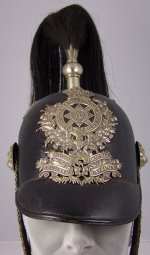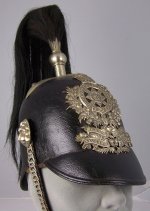RoyalScotsVols
Member
In circa 1797, The Midlothian Yeomanry and The Royal Edinburgh Light Dragoons were formed as a defence against the French armies of Napoleon Bonaparte. Sir Walter Scott (the famous Scottish novelist, poet and historian) was the Quartermaster of the Royal Edinburgh Light Dragoons and wrote the poem ‘Troop Song of the Edinburgh Light Dragoons’ which was originally published in 'The Scots' Magazine in 1802 in tribute to the formation of his old unit. A couple of verses (there are 10 in total) are:
To horse! to horse! the standard flies,
The bugles sound the call;
The Gallic navy stems the seas,
The voice of battles on the breeze,
Arouse ye, one and all!
From high Dunedin's* towers we come,
A band of brothers true;
Our casques the leopard's spoils surround,
With Scotland's hardy thistle crown'd;
We boast the red and blue.**
*The Scottish Gaelic name for Edinburgh
**The Royal colours
Stirring stuff, I’m sure you’ll agree! Flippancy aside, these lines probably capture the spirit of enthusiasm potential recruits had for enlisting to oppose ‘Little Boney’.
In 1800 The Midlothian Yeomanry and The Royal Edinburgh Light Dragoons united to form one regiment of 6 troops forming The Royal Midlothian Yeomanry Cavalry. There was a reduction in the strength of the unit following the end of the Napoleonic Wars although recruitment increased during the social unrest of the following years. The two Edinburgh and Leith Troops were disbanded in 1814 although re-raised in 1819. By 1838 in common with all the Scottish Yeomanry Corps (except for Ayrshire and Lanarkshire) the regiment was disbanded
It was raised again in 1843 possibly at least partly due to the Chartist riots over previous years in England and Wales. The Yeomanry units had long been regarded by the authorities as a politically reliable force which could (if required) be deployed in support of the civil authorities. However, the establishment of civilian police forces and the renewed invasion scares of 1848, 51 and 59 (during the period of French expansionism under Napoleon III) turned the focus of the Yeomanry to national defence. Notwithstanding this, the Royal Midlothian Yeomanry Cavalry was finally disbanded in 1871.
Pictured below is an officer’s helmet from the final years of the regiment comprising a black leather skull with chin chain attached by two lions head ear bosses and with a black horse hair plume. The helmet plate shows a four-pointed star with St Andrews cross, overlaid with the intertwined letters ‘VR’, surrounded by the moto ‘Nemo Me Impune Lacessit’ (No-one provokes me with impunity). This is enclosed within a crown topped garter bearing the moto ‘Honi Soit Qui Mal y Pense’ (Shame on he who thinks evil of it). Around the circlet is a wreath of thistles, below which are the four scrolls bearing the name of the regiment.
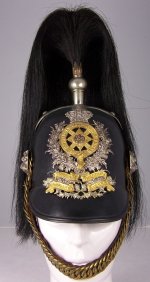
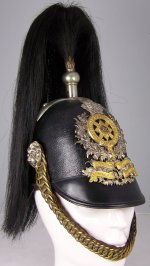
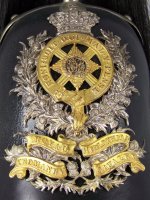
To horse! to horse! the standard flies,
The bugles sound the call;
The Gallic navy stems the seas,
The voice of battles on the breeze,
Arouse ye, one and all!
From high Dunedin's* towers we come,
A band of brothers true;
Our casques the leopard's spoils surround,
With Scotland's hardy thistle crown'd;
We boast the red and blue.**
*The Scottish Gaelic name for Edinburgh
**The Royal colours
Stirring stuff, I’m sure you’ll agree! Flippancy aside, these lines probably capture the spirit of enthusiasm potential recruits had for enlisting to oppose ‘Little Boney’.
In 1800 The Midlothian Yeomanry and The Royal Edinburgh Light Dragoons united to form one regiment of 6 troops forming The Royal Midlothian Yeomanry Cavalry. There was a reduction in the strength of the unit following the end of the Napoleonic Wars although recruitment increased during the social unrest of the following years. The two Edinburgh and Leith Troops were disbanded in 1814 although re-raised in 1819. By 1838 in common with all the Scottish Yeomanry Corps (except for Ayrshire and Lanarkshire) the regiment was disbanded
It was raised again in 1843 possibly at least partly due to the Chartist riots over previous years in England and Wales. The Yeomanry units had long been regarded by the authorities as a politically reliable force which could (if required) be deployed in support of the civil authorities. However, the establishment of civilian police forces and the renewed invasion scares of 1848, 51 and 59 (during the period of French expansionism under Napoleon III) turned the focus of the Yeomanry to national defence. Notwithstanding this, the Royal Midlothian Yeomanry Cavalry was finally disbanded in 1871.
Pictured below is an officer’s helmet from the final years of the regiment comprising a black leather skull with chin chain attached by two lions head ear bosses and with a black horse hair plume. The helmet plate shows a four-pointed star with St Andrews cross, overlaid with the intertwined letters ‘VR’, surrounded by the moto ‘Nemo Me Impune Lacessit’ (No-one provokes me with impunity). This is enclosed within a crown topped garter bearing the moto ‘Honi Soit Qui Mal y Pense’ (Shame on he who thinks evil of it). Around the circlet is a wreath of thistles, below which are the four scrolls bearing the name of the regiment.



Last edited:

